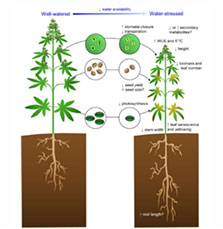Growing Substrate Properties on Cannabis Water Requirement under Greenhouse Condition
Keywords:
cannabis water requirement, growing substrate, greenhouseAbstract
The purpose of this study was to study suitable physical properties of growing substrate on actual cannabis evapotranspiration and reference crop evapotranspiration for calculating cannabis water use coefficient. The results revealed that the growing substrate blending between peat moss: perlite: vermiculite (50: 25: 25) percentage by weight gave suitable of water drainage amount for cannabis growth. Additionally, the cannabis water coefficient different initial (5-6 weeks), vegetative (7-16 weeks) and reproductive stages (17-21 weeks) were adjusted 3.34, 6.08 and 10.6 respectively. It was corresponding with the cannabis growing such as plant height, canopy width and stem width increasing at initial stage were 40.6, 25.3 and 3.2 cm, respectively, following with the vegetative stage were 135.8, 96.1 and 12.6 cm, respectively, as well as the reproductive stage were 187.4, 126.4 and 18.4 cm respectively. Based on the results of water balance equation of actual cannabis evapotranspiration and reference crop evapotranspiration by using Penman-Monteith equation were 2,323.4 and 337.5 mm respectively
References
กรมการแพทย์แผนไทยและการแพทย์ทางเลือก. 2565. การเพาะปลูกกัญชาทางการแพทย์. กรมการแพทย์แผนไทยและการแพทย์ทางเลือก กระทรวงสาธารณสุข. 9 หน้า.
กรมวิชาการเกษตร. 2564. คู่มือเกษตรกรการผลิตพืชสกุลกัญชา (Cannabis sativa L.) เพื่อประโยชน์ทางการแพทย์และอุตสาหกรรม. กรมวิชาการเกษตร กระทรวงเกษตรและสหกรณ์. 152 หน้า.
จักรพงษ์ เจิมศิริ. 2546. วิธีวิเคราะห์สมบัติทางกายภาพของดิน. สำนักวิจัยพัฒนาปัจจัยการผลิตทางการเกษตร กรมวิชาการเกษตร. 72 หน้า.
หนึ่ง เตียอำรุง นันทกร บุญเกิด และ พรรณลดา ติตตะบุตร. 2564. การผลิตและใช้ประโยชน์จากกัญชา. รายงานการวิจัยของมหาวิทยาลัยเทคโนโลยีสุรนารี. 71 หน้า.
Allen, R. G., L. S. Perreira., D. Raes. and M. Smith. 1998. Guidelines for computing crop water requirement. FAO Irrigation and Drainage Paper. 300 p.
Adesina, I., A. Bhowmik., H. Sharma, and A. Shahbazi. 2020. A review on the current state of knowledge of growing condition, agronomic soil health practices and utilities of hemp in the United States. Agriculture 10: 129.
Amaducci, S., M. Errani, and G. Venturi. 2002. Plant population effects on fiber hemp morphology and production. Journal of Industrial Hemp 7: 33-60.
Amaducci, S., M. T. Amaducci., R. Benati, and G. Venturi. 2008. Crop yield and quality parameters of four annual fiber crops (hemp, kenaf, maize and sorghum) in the North of Italy. Industrial Crops Production 11: 179-186.
Barrett, J. and M. Chadwick. 2010. Ecological footprint and water analysis of cotton, hemp and polyester. Cymru, B.D.G.W.
Campbell, B. J., A. F. Berrada, and A. F. Hudalla. 2019. Genotype with environment interaction of industrial hemp cultivars highlight diverse response to environment factors. Agrosystem Geoscience Environment 2: 180-187.
Chandra, S., H. Lata., I. A. Khan, and M. A. Elsohly. 2013. The role biotechnology in Cannabis sativa L. propagation of phytocannabinoids. Biotechnology for Medicinal Plants 123-148.
Clarke, R. C. and M. D. Merlin. 2016. Cannabis Domestication, Breeding History, Present-day Genetic Diversity, and Future Prospects. Critical Reviews in Plant Sciences 35: (5-6). 293–327.
Cosentino, S. L., E. Riggi, and G. Testa. 2013. Evaluation of European developed fiber hemp genotype (Cannabis sativa L.) in semi-arid Mediterranean environment. Industrial Crop Production. 50: 312-324.
Garcia-Tejero, I. F., V. H. Duran-Zuazo., C. Sanchez-Carnenero., A. Hermandez., C. Ferreiro-Vera, and C. Cassano. 2019. Seeking suitable agronomical practices for industrial hemp (Cannabis sativa L.) cultivation for biomedical applications. Industrial Crop Production 139: 1-8.
Gill, A. R., B. R. Loveys, and J. M. Cowley. 2022. Physiological and morphological responses of industrial hemp (Cannabis sativa L.) to water deficit. Industrial Crop Production 187: 115-121.
Gill, A. R., B. R. Loveys., T. R. Cavagnaro, and R. A. Burton. 2023. The potential of industrial hemp (Cannabis sativa L.) as an emerging drought resistant fiber crop. Plant Soil. 10 p.
Gordon, S. and R. Brodrick. 2020. A comparative analysis of cotton and hemp production in Australia. The Australian Cotton Grower 42-45.
Lisson, S. and N. Mendham. 1998. Response of fiber hemp (Cannabis sativa L.) to varying irrigation regimes. Journal International Hemp Association 5 (1): 9-15.
Schumacher, A. G. D., S. Pequito, and J. Pazour. 2020. Industrial hemp fiber: A sustainable and economical alternative of cotton. Journal of Cleaner Production 268: 108-122.
Scordia, D., E. G. Papazoglou, and D. Kotoula. 2022. Toward identifying industrial crop type and associated agronomies to improve biomass production from marginal lands in Europe. GCB Bioenergy 14: 710-734.
Struik, P., S. Amaducci., M. Bullard., N. Stutterheim., G. Venturi, and H. Cromack. 2000. Agronomy of fiber hemp (Cannabis sativa L.) in Europe. Industrial Crop Production 11: 107-118.
Tang, K., A. Fracasso, and P. C. Struik. 2018. Water and nitrogen use efficiency of hemp (Cannabis sativa L.) based on whole-canopy measurement and modeling. Front Plant Science 9: 1-14.
Upton, R., L. Craker., M. Elsohly., A. Romm., E. Russo, and M. Sexton. 2013. Cannabis inflorescence: cannabis spp; standard of identity, analysis and quality control. American Herbal Pharmacopoeia. Scott Valley. California.
Wilson, H., H. Bodwitch, and J. Carah. 2019. First known survey of cannabis production practices in California. California Agriculture 73: 3. 119-127.
Zheng, Z., K. Fiddes, and L. Yang. 2021. A narrative review on environmental impact of cannabis cultivation. Journal Cannabis Research 3: 35-45.






